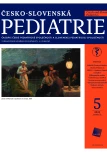Burkholderia cepacia complex infections in patients with cystic fibrosis: detection and containment of the outbreak
Authors:
Dřevínek Pavel; Antušková Milena
Authors‘ workplace:
Motol, Praha
; 2. lékařská fakulta, Univerzita
; Karlova a Fakultní nemocnice
; Ústav lékařské mikrobiologie
Published in:
Čes-slov Pediat 2023; 78 (5): 251-253.
Category:
doi:
https://doi.org/10.55095/CSPediatrie2023/041
Overview
Bacteria from the Burkholderia cepacia complex cause severe lung infections in people with cystic fibrosis (CF). The risk of epidemic spread of the infection led the CF centres to implement strict isolation precautions. Furthermore, it was imperative to identify the microbial agent correctly and timely which was made possible thanks to the methods of molecular microbiology. No new Burkholderia cenocepacia infections, caused by the ST-32 strain which had been responsible for a large outbreak in 1990s, were diagnosed in the Czech Republic in the last ten years.
Keywords:
Cystic fibrosis – Burkholderia cepacia complex – epidemic strain
Sources
1. G ibson RL, Burns JL, Ramsey BW. Pathophysiology and management of pulmonary infections in cystic fibrosis. Am J Respir Crit Care Med 2003; 168(8): 918–51.
2. O renti A, et al. ECFSPR Annual Report 2020. 2022.
3. I sles A, et al. Pseudomonas cepacia infection in cystic fibrosis: an emerging problem. J Pediatr 1984; 104(2): 206–10.
4. Vandamme P, Dawyndt P. Classification and identification of the Burkholderia cepacia complex: Past, present and future. Syst Appl Microbiol 2011; 34(2): 87–95.
5. Jin Y, et al. Genome-based classification of Burkholderia cepacia complex provides new insight into its taxonomic status. Biol Direct 2020; 15(1): 6.
6. M ahenthiralingam E, et al. DNA-Based diagnostic approaches for identification of Burkholderia cepacia complex, Burkholderia vietnamiensis, Burkholderia multivorans, Burkholderia stabilis, and Burkholderia cepacia genomovars I and III. J Clin Microbiol 2000; 38(9): 3165–73.
7. D revinek P, et al. Direct PCR detection of Burkholderia cepacia complex and identification of its genomovars by using sputum as source of DNA. J Clin Microbiol 2002; 40(9): 3485–8.
8. D revinek P, et al. Diversity of the parB and repA genes of the Burkholderia cepacia complex and their utility for rapid identification of Burkholderia cenocepacia. BMC Microbiol 2008; 8: 44.
9. Baldwin A, et al. Multilocus sequence typing scheme that provides both species and strain differentiation for the Burkholderia cepacia complex. J Clin Microbiol 2005; 43(9): 4665–73.
10. S pilker T, et al. Expanded multilocus sequence typing for Burkholderia species. J Clin Microbiol 2009; 47(8): 2607–10.
11. M ahenthiralingam E, Urban TA , Goldberg JB. The multifarious, multireplicon Burkholderia cepacia complex. Nat Rev Microbiol 2005; 3(2): 144–56.
12. D revinek P, et al. Widespread clone of Burkholderia cenocepacia in cystic fibrosis patients in the Czech Republic. J Med Microbiol 2005; 54(Pt 7): 655–9.
13. Dedeckova K, et al. PCR detection of Burkholderia cepacia complex as one of key factors to handle a long-term outbreak. J Cyst Fibros 2012; 11(5): 440–445.
14. D revinek P. (Bacteria of the Burkholderia cepacia complex: epidemiology and diagnosis of infection in patients with cystic fibrosis). Epidemiol Mikrobiol Imunol 2014; 63(1): 18–26.
Labels
Neonatology Paediatrics General practitioner for children and adolescentsArticle was published in
Czech-Slovak Pediatrics

2023 Issue 5
Most read in this issue
- Heart murmur in children
- Prevention in paediatrics
- New therapies in cystic fibrosis
- Burkholderia cepacia complex infections in patients with cystic fibrosis: detection and containment of the outbreak
